
|
Cococubed.com
|
| Pre-Supernova Variations |
Home
Astronomy research
Software Infrastructure:
MESA
FLASH-X
STARLIB
MESA-Web
starkiller-astro
My instruments
Neutrino Emission:
Neutrinos from de-excitation
Neutrino emission from stars
Identifying the Pre-SN
Neutrino HR diagram
Pre-SN Beta Processes
Pre-SN neutrinos
White dwarf pulsations:
12C(α,γ) & overshooting
Probe of 12C(α,γ)16O
Impact of 22Ne
Impact of ν cooling
Variable white dwarfs
MC reaction rates
Micronovae
Novae
White dwarf supernova:
Stable nickel production
Remnant metallicities
Colliding white dwarfs
Merging white dwarfs
Ignition conditions
Metallicity effects
Central density effects
Detonation density
Tracer particle burning
Subsonic burning fronts
Supersonic fronts
W7 profiles
Massive stars:
Pop III with HST/JWST
Rotating progenitors
3D evolution to collapse
MC reaction rates
Pre-SN variations
Massive star supernova:
Yields of radionuclides
26Al & 60Fe
44Ti, 60Co & 56Ni
SN 1987A light curve
Constraints on Ni/Fe
An r-process
Effects of 12C +12C
Neutron Stars and Black Holes:
Black Hole spectrum
Mass Gap with LVK
Compact object IMF
He burn neutron stars
Stars:
Hypatia catalog
SAGB stars
Nugrid Yields I
He shell convection
BBFH at 40 years
γ-rays within 100 Mpc
Iron Pseudocarbynes
Pre-Solar Grains:
C-rich presolar grains
SiC Type U/C grains
Grains from massive stars
Placing the Sun
SiC Presolar grains
Chemical Evolution:
Radionuclides in 2020s
Zone models H to Zn
Mixing ejecta
Thermodynamics, Opacities & Networks
Radiative Opacity
Skye EOS
Helm EOS
Five EOSs
Equations of State
12C(α,γ)16O Rate
Proton-rich NSE
Reaction networks
Bayesian reaction rates
Verification Problems:
Validating an astro code
Su-Olson
Cog8
Mader
RMTV
Sedov
Noh
Software Instruments
AAS Journals
2025 AAS YouTube
2025 Listing of 500+ Author Videos
2025 AAS Peer Review Workshops
2025 ASU Energy in Everyday Life
2025 MESA Classroom
Other Stuff:
Bicycle Adventures
Illustrations
Presentations
Contact: F.X.Timmes
my one page vitae,
full vitae,
research statement, and
teaching statement.
In this paper by Farmer et al we explore the variation in single star 15-30 M☉, non-rotating, solar metallicity, pre-supernova MESA models due to changes in the number of isotopes in a fully-coupled nuclear reaction network and adjustments in the mass resolution. Within this two-dimensional plane we quantitatively detail the range of core masses at various stages of evolution, mass locations of the main nuclear burning shells, electron fraction profiles, mass fraction profiles, burning lifetimes, stellar lifetimes, and compactness parameter at core-collapse for models with and without mass loss. Up to carbon burning we generally find mass resolution has a larger impact on the variations than the number of isotopes, while the number of isotopes plays a more significant role in determining the span of the variations for neon, oxygen and silicon burning. Choice of mass resolution dominates the variations in the structure of the intermediate convection zone and secondary convection zone during core and shell hydrogen burning respectively, where we find a minimum mass resolution of ≈0.01 M☉ is necessary to achieve convergence in the helium core mass at the ≈5% level. On the other hand, at the onset of core-collapse we find ≈30% variations in the central electron fraction and mass locations of the main nuclear burning shells, a minimum of≈127 isotopes is needed to attain convergence of these values at the ≈10% level.
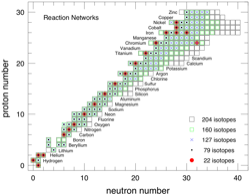 networks |
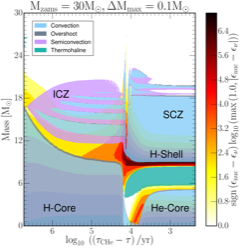
h-burn kippenhahn |
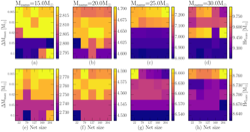
he core masses |
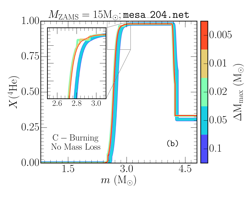 he shell location |
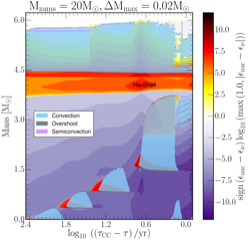
c-burn kippenhahn |
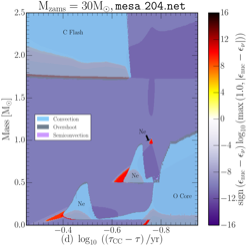
ne-burn kippenhahn |
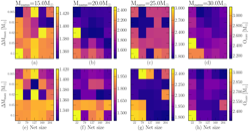 oxygen core mass |
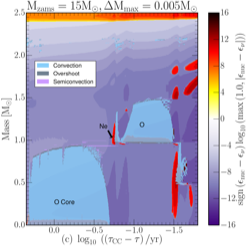
o-burn kippenhahn |
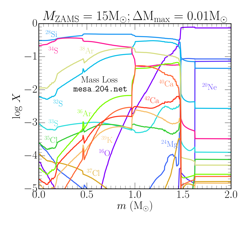
oxygen depletion |
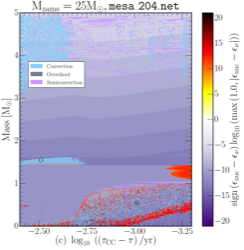 si-burn kippenhahn |
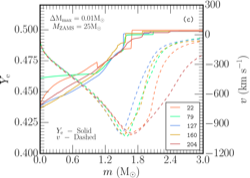
core collapse |
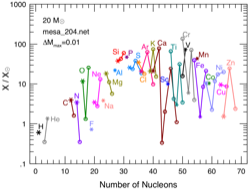
yields |